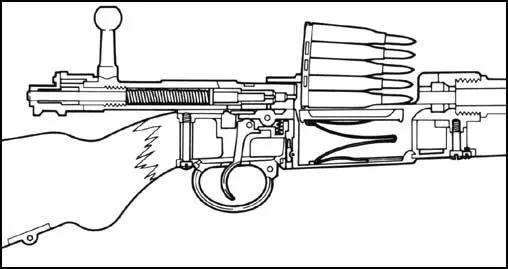Bolt Action Rifle
Nearly all infantryman in the First World War used bolt action rifles. This type of rifle had been invented by a Scottish immigrant to the United States, James Paris Lee. The bolt is the device that closes the breech of the barrel. The bolt-action rifle had a metal box, into which cartridges were placed on top of a spring. As the bolt was opened, the spring forced the cartridges up against a stop; the bolt pushed the top cartridge into the chamber as it closed. After firing, the opening of the bolt extracted the empty cartridge case, and the return stroke loaded a fresh round.
Cartridges were injected into the magazine by means of a clip. They consisted of open-ended slides or cases within which a number of cartridges, 3, 5 or 6 were gripped by the spring metal of the case or a spring incorporated in the base.
The Lee-Enfield was the main rifle used by the British Army during the First World War. Other popular bolt action rifles included the Mauser Gewehr (Germany), Lebel (France), Mannlicher-Carcano (Italy), Springfield (United States), Moisin-Nagant (Russia), Mannlicher M95 (Austria) and Arisaka (Japan).

